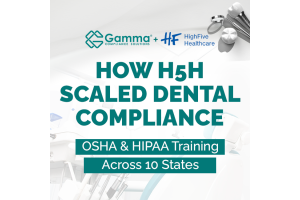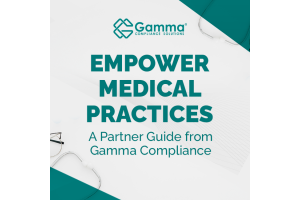Case Study: Documenting a Minor Workplace Injury and Employee Refusal for Medical Follow-Up in a Dental Office
Disclaimer: The name used in this case study has been changed to protect the identity of the individual involved.
The Scenario
As a consulting company, we frequently work with dental offices to help them navigate workplace safety protocols and ensure compliance with industry regulations. One critical area of focus is managing workplace injuries, particularly when employees may refuse medical follow-up after an exposure incident. In this case study, we’ll walk you through how our client’s dental office handled a minor injury, the refusal of medical follow-up, and the proper documentation processes that followed.
One of our client’s dental assistants, Emma, sustained a minor scratch on her right hand while cleaning dental instruments in their dental office. While the injury appeared to be insignificant, the dental office followed their standard safety protocols and offered Emma the option of having her blood tested by a healthcare professional. This step was intended to assess any potential exposure to bloodborne pathogens such as HIV, Hepatitis B (HBV), and Hepatitis C (HCV).
However, Emma declined the offer to go to the medical clinic and refused to undergo blood testing or a follow-up evaluation by a licensed healthcare provider. Despite the injury being minor, it still required thorough documentation to ensure compliance with OSHA regulations and to protect both the employee and the organization.
Step 1: Complete the Employee Exposure Report
The first step in responding to the injury was for our client’s dental office to complete the Employee Exposure Report, which is a key form for documenting workplace injuries that involve potential exposure to bloodborne pathogens. This form can be found in the Welcome Kit > Documentation Kit > Exposure Forms.
The Employee Exposure Report includes detailed information about the injury, the employee’s health status, and any actions taken following the exposure incident. For Emma’s case, the report included the following details:
- Injury Description: Emma sustained a minor scratch on her right hand while cleaning dental instruments.
- Exposure Potential: Although the injury was minor, it’s essential to assess the risk of bloodborne pathogen exposure in a dental setting where instruments are in close contact with bodily fluids.
- Offer of Medical Follow-Up: The dental office offered Emma the opportunity to see a healthcare professional for blood testing and follow-up care, in line with OSHA’s Bloodborne Pathogens Standard (1910.1030).
Since Emma refused the medical evaluation, this refusal was clearly documented in the form, noting her decision to decline blood testing.
Step 2: Provide Counseling to the Employee
OSHA requires that when an employee refuses medical follow-up, the employer must provide counseling to the employee. This counseling ensures the employee understands their rights, the risks associated with the exposure, and the potential consequences of refusing medical care.
In this case, we advised our client’s dental office to explain the following to Emma:
- Right to Follow-Up Care: Emma was informed of her right to follow up with a healthcare professional to assess any potential risks associated with the exposure.
- Right to Blood Testing: It was made clear to Emma that she had the right to undergo blood testing for HIV, Hepatitis B, and Hepatitis C to ensure her health and safety.
- Self-Monitoring for Symptoms: Emma was advised to monitor herself for any symptoms that could arise as a result of the exposure, such as flu-like symptoms or jaundice, which could indicate a potential infection.
- Risks of Bloodborne Pathogens: The risks of exposure to bloodborne pathogens, including HIV, HCV, and HBV, were discussed with Emma, highlighting the importance of timely medical evaluation.
This counseling was carefully documented in the Employee Exposure Report to confirm that Emma’s decision to refuse medical follow-up was fully informed.
Step 3: Record the Refusal of Medical Evaluation
After offering counseling and providing all the necessary information, Emma still chose to decline the offer for medical evaluation. This decision was documented in the Employee Exposure Report, ensuring compliance with regulatory requirements.
Even though Emma declined medical evaluation, the documentation had to be comprehensive. The report included:
- The specific medical follow-up that was offered.
- Emma’s refusal to go to the clinic.
- The counseling provided to Emma regarding her rights and the risks associated with the exposure.
Step 4: Follow Incident Protocol
Despite the minor nature of the injury, the dental office followed all standard protocols for workplace exposures involving bloodborne pathogens:
- Initial First Aid: After the injury occurred, Emma was immediately provided with first aid to clean and disinfect the scratch.
- Source Identification: The office attempted to identify the source of the potential exposure. Since Emma’s injury was caused by cleaning instruments, there was no identifiable source individual.
- Documentation of Actions Taken: All actions taken, including offering medical evaluation and counseling, were carefully recorded in the Exposure Control Plan and associated forms.
Step 5: Maintain Confidential Records
As required by OSHA regulations, all exposure documentation was stored confidentially in Emma’s employee file. According to OSHA guidelines, exposure-related records must be maintained for a minimum of 30 years.
This ensures that if any health issues arise in the future, there is a complete and accurate record of the incident and the decisions made at the time.
Why Documentation Matters
Proper documentation is critical in cases like Emma’s, where an employee refuses medical follow-up. Detailed records protect both the employee and the employer by ensuring that the employee’s rights are respected and that the organization is in compliance with OSHA regulations.
In Emma’s case, although the injury was minor, documenting the offer of medical follow-up, the counseling provided, and Emma’s refusal ensures that all necessary steps were taken to address the incident responsibly. If any health concerns arise later, the documentation provides a clear record of the actions taken at the time.
Conclusion
This case study demonstrates the importance of thorough documentation when managing minor workplace injuries, especially when an employee refuses medical follow-up. By following the proper protocol and documenting every step of the process, we can ensure that both the employee’s health and safety rights are protected, and the organization remains in compliance with safety standards.
For more detailed guidance, refer to your Exposure Control Plan and associated documentation forms, and ensure that all employees are trained on bloodborne pathogen protocols. Proper training and documentation help prevent future issues and ensure a safe, compliant work environment.








